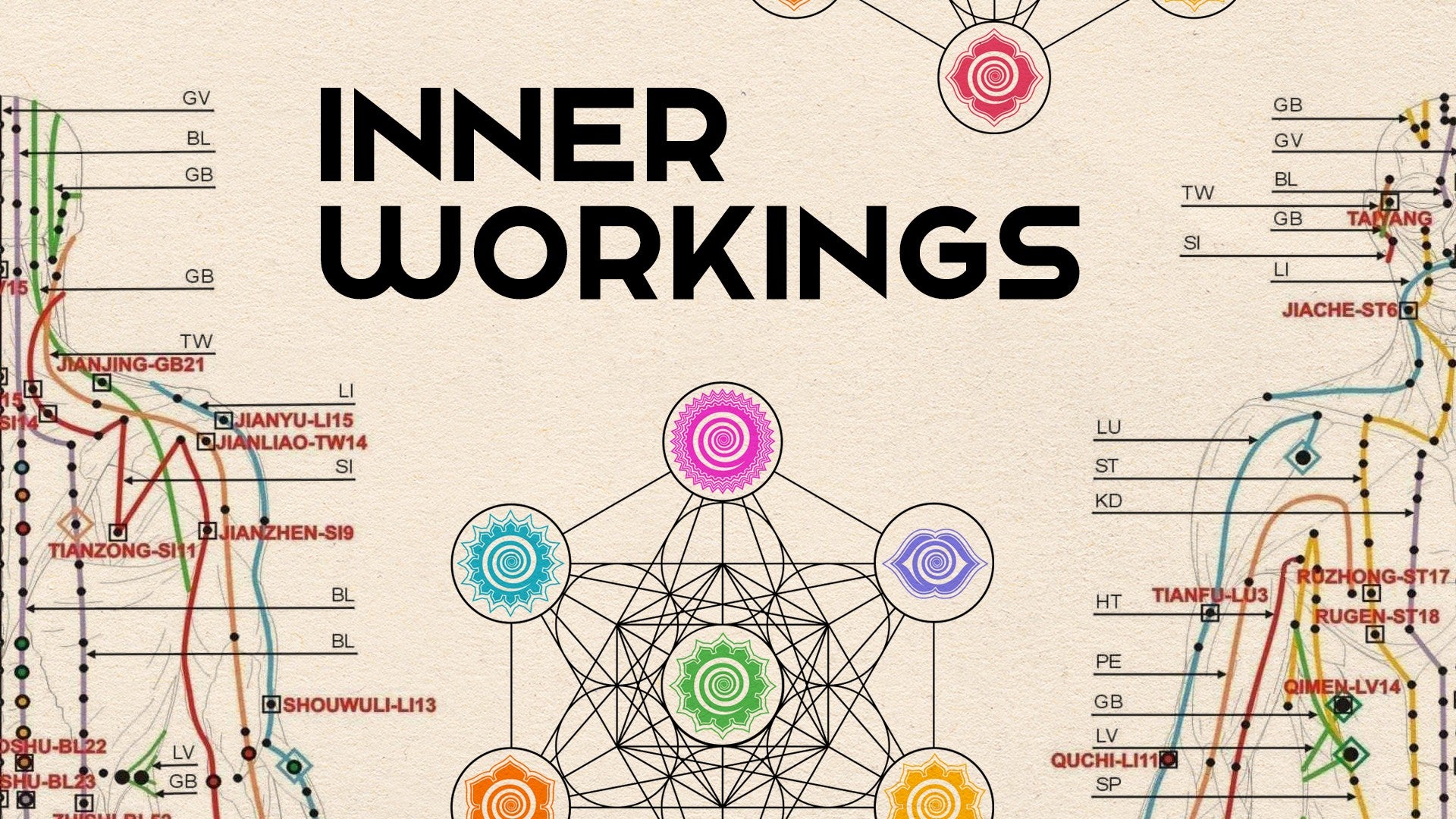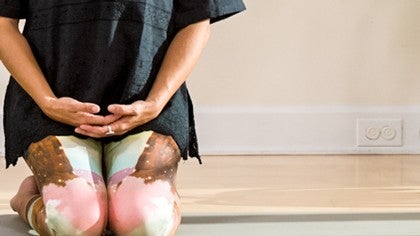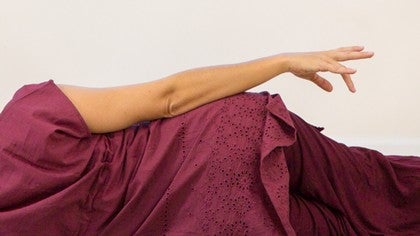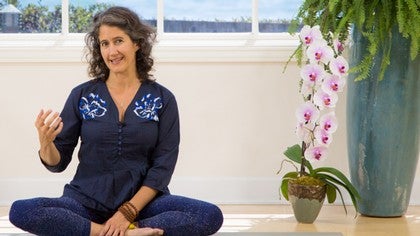Description
About This Video
Transcript
Read Full Transcript
(waves crashing) So much conversation about coordinating the movements with the breath, and yet, right after that, the question that needs to be asked is, what is the breath coordinated to? What is the breath connected to? So in the sequence today, what we'll play with is just tuning into various alignments of the mind, and to find out how the breath responds. Now, again, the key quality of these experiments is that you show up like a yogi scientist. The problem with the word scientist, because of how science is now currently done, is that it implies that we would continually look for controllable, predictable results.
But to be a yogi scientist is to be able to look anew and look anew and look anew, and see what's happening right now. The key components of being a yogi scientist is this willingness to not already know all there is to know. Simultaneously, a quality of curiosity and wonderment. In fact, we can even look to the text for assistance in the Shiva Sutras, Sutra 1.12. Please excuse my Sanskrit, but it's something like (speaking in a foreign language), which essentially translates as wonderment is the foundation of yoga.
So what we'll do today, we'll lie down. We'll just get a little easy opener. We'll tune into the breath. We'll start to play with mantra. Now, mantra has a couple different definitions.
Ma is the Sanskrit for to measure. Manas is often the word used to define the mind. Tra is the word for protection. So one definition of mantra is protection from our own minds. Another definition that's quite popular is instrument.
So mantra is a way of playing a particular instrument. Like some of the other sequences that we've already done, we'll let our breath be our teacher because our breath, yes, our breath, our most intimate, long-lasting relationship, and she never lies. I'm pretty sure all you need for this is something to sit on comfortably. I have both a blanket and two bricks. You might have something else.
We'll start supine. I'm on a yoga mat. You may or may not have one. You'll be okay without one. Oh.
I'm gonna adjust my ponytail, and since the '80s have come back, side ponytail. Yes. (laughs) Gonna reach my arms up over the top of my head, adjusting my yoga costume. My knees are bent, my soles of the feet are on the floor. We're gonna start with how we usually start, windshield wiper. Inhale here, and as you exhale, roll onto the edges of the feet, knees to the side.
Inhale, back center. Exhale, knees to the other side. If you've been practicing with us for a while, you know we love to start like this. (laughs) Inhale, knees center. Exhale, knees to a side. Inhale, knees center.
Exhale, knees to a side. All you're trying to do here is kinda get in the mood. It's not so easy. We often talk about, we use different words for mind and body and breath. When we use these different words, we imply that they're separate.
Yet, they do have somewhat different qualities. So the mind generally likes to be anywhere but here. The body, for most of us, is generally right here. So the play is to let the breath be the bridge to start to let the two know that they're connected. What happens is if you, so, if you do coordinate the movement with the breath, so inhale, knees center, exhale, knees to a side, and inhale, knees center, and exhale, knees to a side, you'll have more chance of feeling the connection.
Just get used to the mutiny because the problem is, is to be right here and now, to make the decision to be right here and now is to be out of the story of the past and the future. As soon as you move out of the story of the past and the future, you lose a little bit of the sense of what the yogis call the small eye. Next time, next time you find your knees over to the left, so that you're stretching your right side, just stretch a little bit more. This is how we're gonna start to make sure that we're connected to the breath. You're lengthening through the right arm.
You're rolling the right hip away. You're feeling this in between the ribs. Inhale, bring your knees back center. Exhale, knees over to the other side. Now my knees are to my right.
I'm lengthening on my left side. Shh. Nice. Inhale, knees back center. Now we're gonna repeat that.
This time, as your knees come over to the left and you're lengthening on your right, the request is can you become more aware? Let your awareness come in a little deeper to the right lung. Usually when we become aware of the right lung, we tend to more aware of the front and center. So please put a little bit more attunement to the back bottom. Feel the expansion and the contraction.
Yes. Start to really be aware of the inspiration and the expiration. Now bring your knees back up center. Exhale, knees over to the other side. Same idea, lengthen.
As you're lengthening, now you're aware of the left side and the left lung. We've brought our attention to this previously, and yet the play here is like, as you feel this left side and you're aware of the movement of the breath in this left lung, is it obvious that the left lung is smaller? About 1/3 smaller than the right lung because she's scarified a part of herself for the heart. One of the reasons to start to become aware of this, sometimes we think self-awareness, we think of it as this big, grand thing, but self-awareness is like, please, can you become aware of what's right underneath your nose? Now bring your knees back center.
Then one more time, each side. Knees over to the left. I'm lengthening on my right side and rolling. Just feel that lengthen. The play here again is, is it obvious as you come back into the right lung, is it obvious that she's larger?
Is that obvious? Is it obvious that she's the one that does more of the work in that way? This is how the yogi becomes curious because the answer could simply be no, and you could be done with the investigation. But the request to start to investigate a little bit deeper is to be interested. We can only be interested in what we don't already know the answer to.
Nice. Super nice. On inhale, now bring your knees back up center, and then one more time other side. Knees over, knees over to the right. You're lengthening on the left side.
Again, you're in this left lung. She's wrapping her arms around the heart. Is it obvious that she's smaller? Can you even be aware of the heart? This is just this moment of there's your heart.
There she is, beating, and there's been no thought on your part to remember to beat. This is really, like Einstein says, we can live our life in two ways, as if nothing is a miracle or as if everything is. So starting to become more aware of the miracle that's happening right there underneath your nose. Nice. Now bring your knees back up center.
Let your arms come back down along your side. Now we wanna make sure you're quite comfortable because we wanna be able to bring our awareness into the breath and become tuned to here. Notice this. Try widening your feet a little bit. Just let your knees fall together.
Just see how this feels on your low back and through your hips. Just be aware of how this is for you. Now in comparison, try this. Soles of the feet together, knees dropping out wide. This, for you, might be the most comfortable.
You might decide that you wanna stay here. If you're still not sure, a third option might be to extend your legs straight. I like to usually do one leg at a time. It just feels better. Find out if this is the most comfortable for you and your low back 'cause we'll be here for maybe about, I'm gonna guess about four minutes.
So you wanna be quite comfortable. For me, knees bent, soles of the feet wide, about as wide as my mat, knees falling together. This, for me, is ideal. Big deliberate inhale and exhale everything. Let your eyes close.
As you let your eyes close now, let your awareness come back down into your lungs. I find it difficult to bring my awareness to both lungs, so just let your awareness maybe start at the right lung. With your awareness in the right lung, feel the expansion and feel the ease. Now, move your mind over to the left lung. As you move your mind over to the left lung, be aware of her, be aware of her tenderness to the heart.
Nice. Now start to become aware of the diaphragm, this amazing muscle that sits just underneath the lungs and the heart. She's this beautiful bowl-shaped muscle that's tethered to the fifth rib. The heart is intimately connected to her through the pericardium and other connective tissues. You might feel your breath expand a little bit as you become aware of her.
She reaches her connective tissue, her fingers, down your back, deep into your sacrum. Is this obvious? Nice. Now just underneath the diaphragm, just below the diaphragm, right in the center of the torso, sits this little spot, this little spot that our Taoist brothers and sisters refer to as the true heart. The yogis refer to this spot as the wish-fulfilling tree.
Most people feel it kind of in the center. Some feel it slightly to the left. You'll know you've found it 'cause it has this hollow quality. It's funny, today I'm feeling it a little bit more to the left. Interesting.
If that was a little too esoteric for you, go back to something more tangible, like the diaphragm or even the heart. Just let this be your perch spot. Hold your awareness here. Hold your awareness here. Eyes are closed.
Be aware of your breath. Then eventually, on an upcoming inhale, so at any point in time, as you're ready, on an upcoming inhale, please hear the word love. Then let it be quiet on the exhale. As you inhale, you internally hear the word love. Then let it be quiet on the exhale.
There's a timing here. You'll just kind of be able to feel. When the timing's right, it'll feel like the word is like a sail that the breath is filling, and then it's quiet on the exhale. This is our first experiment today. You're just observing.
There may or may not be data. A couple more moments. Maybe one or two more, depending on your pace. Nice. Beautiful.
Relax the effort of that and just rest in the effect, rest in the effect of specifically tuning your mind and observing your breath. Nice. When you feel ready, let your knees come into your chest. Wobble. (laughs) Cross your ankles.
Inhale, roll back. Exhale, roll up to sitting. I'm gonna adjust my side ponytail. Just give me a moment. Now here's the play.
Maybe that experiment worked, maybe it didn't. We're gonna continue the experiment. Find something like (speaking in a foreign language), shin to shin, feet flexed. If (speaking in a foreign language) isn't comfortable for you, you make an adjustment. Sometimes people like to put a blanket underneath the knee that's mischievous, sit up on something, put some bricks.
Some days the knee's just not bending, so you work with a straight leg. We approximate these situations. (speaking in a foreign language), or your personal variation. Bring your awareness back to this spot. I've suggested this spot, this little wish-fulfilling tree, true heart.
You might be more in the diaphragm or the heart, but tune back into this spot. The word love, in Sanskrit, the word is calm. The word love is one of our early truths from our sages. In fact, in the 10th Mandala of the Rigveda, which is one of our first texts, it says something like, and I don't have the quote exactly right, but it's something like love is all there is. This wasn't a new idea in the '60s.
This has been an idea for a while. You tune back into this spot. You're leaning forward. Maybe the word love, as you inhale, and quiet as you exhale. Maybe the word love feels correctly inspiring.
Maybe it's just the right word for you toady. But some of the other truths that our early sages have given us, this word of (speaking in a foreign language), which is vastness, or maybe the word is vastness. You hear the word vastness on the inhale, and it's quiet on the exhale. Maybe that's not quite the word. Maybe it's something closer to the word truth or (speaking in a foreign language).
Some of you are gonna stay here, some of you are gonna choose to walk your hands more forward. As you choose to walk your hands more forward, you're still tuning into that spot, you're still tuning into your mantra. The truth is, you're gonna hear a word that really works for you. I'm sharing some of our early words from our early sages, but you're gonna hear a word that's right. You might hear the word joy or peace or freedom or liberation.
You're only walking your hands as far forward as feels correct. This might be the spot. Some of you might let your elbows bend. I like to turn my palms up. Palms down sometimes feels safe and secure and like you're gonna make it, but palms up is just so much more truthful of (laughs) help.
(laughs) You're tuning to the mantra. If you haven't yet found it yet, no big deal, but you're looking for that word that has that quality of openness. Inhale, lift up just enough. You're gonna walk your hands over. For you, this is your left.
Heart's coming out over that front knee, tuning to that mantra. Then you continue till your left forearm comes down to the earth. This bottom forearm comes down to the earth. You'll circle this top arm up. You'll let your elbow bend.
What I like to do here is I like to kinda let my elbow bend and let my knee come in a little bit. Then I like to roll this hip away and reach this arm away. I like to let the hip come up off the floor, let myself kinda come in. Then I like to re-reach. I'm gonna do that one more time.
Then re-reach. So the play here now is you're reaching. You could be aware of this top lung. We've been tuning this. You could be aware of the bottom lung.
The play, the request, is please be more aware of your mantra. Tune to the word that holds you. Again, that word might be freedom, that word might be love. You're looking for a truth that's bigger. Take a look down at that hand on the earth, and let yourself come all the way up.
Just kinda pause. Enjoy the results. Literally, the request is sit in your own sauce. Other side. You switch.
We learn through comparison and contrast, so what we'll do now is snuggle in. Tune into this spot. Lean in. Don't take my word for it. The play here is we've gotta do our own experiments.
In fact, the Buddha is rumored to have said something like, don't believe what I have to say. Judge your own experience. Right here now, just for the fun of it, choose a word that's a little less inspiring. Choose a word like cardboard. (laughs) Just as you inhale, hear the word cardboard. As you exhale, let it be quiet.
Just see, tune into something like this. I'm suggesting cardboard. You might have your own word. Just see what the alignment of the mind with a word like cardboard does to the breath. This might not be happening at home for you, but usually it's a little less inspiring than a word like vastness.
Go back to your mantra. This might be deep enough of a forward fold for you. Some of you might be letting your hands come a little more forward. Wobble in there a little bit. This might be deep enough.
You're tuning. Word, it's more like you're hearing the word. It's not so much that you're saying it mentally. It's more like it's arising within you, like a vibration. This might be the perfect spot.
Some of you might come down onto your elbows. Again, you decide. You might feel quite sorted with the hands down. I like palms up. There's just this sweet vulnerable quality.
It helps me feel more vulnerable, more tender. I need help feeling like that. I'm good at feeling like this. This is what I'm working on. You're tuning, you're listening.
This is, again, a practice of (speaking in a foreign language), steady attention. You're studying the breath because she doesn't lie to you. She loves to be inspired, like all of us love to be inspired. You might snuggle in a little more. As you're ready, you'll inhale, you'll lift up enough, you'll walk your hands over.
If you're mirroring me, this is your right. Lengthen out. Then when you feel ready, you'll continue. Your bottom arm comes down to the earth. You let this hip come up off the floor.
You circle this arm in front of the face and up. Let the elbow bend. Then again, what I like to do is let this hip come in towards me. Then reach it away. Let it come in towards me.
Then reach it away. Let this come in towards you, and then reach away. Then as you reach away, you're rolling that hip away. You're reaching this arm away. You're finding an opportunity.
You could just be in this side stretch. That's a lot to focus on. You could just be here. You could be in this bottom lung, but you could also just tune your attention to the mantra. Just notice what happens.
We're experimenting here. If you align your mind with a quality of joy, vastness, light, truth, whatever the word is that happened to have occurred for you, what happens in the breath? Take a look down at the left hand, or the bottom hand, excuse me. For you, it was your right. Come on back up.
Pause. Nice. Beautiful. So what we'll do next, we'll just move a little bit. The purpose of moving a little bit is just to help move some of this work, and it's to really get sorted so that we can do a second breath experiment with more effectiveness.
Come to the back of your mat. Adjust your yoga costume. Then come onto all fours. As you come onto all fours, as you line the heels of your palms underneath you, not every wrist love this. In fact, more and more, I find that I usually end up on my fingertips.
This just sometimes feels better. Some people, I find, love to be on their fists. This with the palms spread wide might feel great. You just adjust this so it feels good. Then I find that I just end up crossing one ankle over the other.
You may or may not, but I just find that that just almost always happens. We're gonna move into what the yogis usually call ye old cat cow. As you exhale, you draw (laughs) your sit bones under and you get round. As you inhale, you roll your pelvis forward and you arch. As you exhale, you get round.
As you inhale, you arch. Just a few more times like this, just 'cause it feels good. Then the play is can you remember your mantra? Because it's one thing to align the mind when things are relatively calm and still. It's another thing to maintain the alignment of the mind when things are moving.
Super nice. Next time you're rounding, next time you're in the rounded shape, stay rounded and curl your sit bones back. You're gonna come into what we usually call child's pose. Sit bones are drawing towards the heels, hands are walking forward. Now, if this isn't the medicine for your knees, hips and ankles, don't do it.
Stay up on all fours. We'll be right back. Press into the hands and wiggle. Nice. Then from here, we'll come back up onto all fours.
Spread the fingers super wide. Soften the elbows, let the shoulders roll back and down. Gooey in the back of the neck. Now tuck the toes under. Lift up through the backs of the legs and wiggle on back through the heels.
This is what we usually end up calling this plank pose. Inhale here. As you exhale, you're gonna draw your sit bones back. Let your knees bend a little bit, so it's a little bit more relaxed. Elbows soft, shoulders roll back and down.
You're coming back into what we usually call down dog, which lately, in the modern days, the hardest working yoga pose around. Let your heels get heavy. Then can you feel the mantra? Do you remember how to inhale and hear the word? Do you remember how to exhale and let it be quiet?
Nice. The play here, what we're gonna do next is we're just gonna take a simple lunge, letting your right foot find her way between your hands. That doesn't always work out that simply. Sometimes the right foot ends up back here. In that case, you just help her along.
(laughs) Wiggle back through here. Curl the sit bone under, let than knee come down to the earth. Now inhale, drawn back a little bit. Exhale, sink in. Inhale, draw back a little bit.
Exhale, sink in. Do that one more time. Inhale, draw back a little bit. Exhale, sink in. Hips sinking in, soft in the back of the neck.
All we're doing here, we're just getting a little opening through the front of the thigh. Easy in the mouth, easy in the jaw. Then come back to the mantra. Again, the play here, what we're doing here in just offering a little bit of movement is we're just getting used to holding the mind steady, even when there are other things going on. The purpose of the yoga practice is your life.
Maybe you spend, what, somewhere between 20 minutes to two hours on this little piece of rubber, but that leaves a good, solid 22 hours in the rest of the day. (laughs) Being able to hold things steady when real things are occurring. Last few moments. In these last few months, some of you might choose to say low. Some of you might like a little bit more opening, in which case hands might come up onto this front knee.
What I like to do is back off a little bit. What I like to do is back off a little bit and interlace your fingers and reach them up over the top of your head. Lengthen. (laughs) I'll tell you guys what's happening is I wasn't sure if my hands would stay in frame or not as I did that. (laughs) Curl the sit bones under as you sink in. Wobble.
Last few beats, mantra. Nice. Inhale here, exhale, hands come back down around that foot, nice. Walk your hips back. Give a little stretch to the hamstring 'cause it'll feel good.
Just kinda dig the heel in, lengthen through the heart. Can you still be with your mantra? Let that knee bend. Your choice. Here you could find your way back into child's pose or you could lift up through the back of this back leg and step back, downward-facing dog.
Whatever seems more pleasant. Wiggle. Super nice. Other side. Again, that was annoying because I made that look like it was really easy.
(laughs) This might happen, in which case you'll have to do this. (laughs) Wiggle back through here. Curl the sit bone under, let this knee come down to the earth. Inhale, back off. Exhale, sink in.
Inhale, back off. Exhale, sink in. What you're doing, we've talked about this before. When you move in and out of something, you communicate to the nervous system that she has an exit route. When she knows she has an exit route, she'll relax.
It's like here in Southern California, everybody needs their own car at the party because at any moment, you might wanna leave. (laughs) There'll be seven Priuses, as opposed to one Suburban. Back off, sink in. Now, as you start to sink in, you're soft in the mouth, you're easy in the eyes. The play here, because as you're drawing the sit bone under, most likely you're feeling it a little bit through the front of that thigh.
Can you also stay in the mantra? A good experiment here, which I find really useful, is here you are, you're in this thigh stretch. I'm suggesting to be in the mantra. As an alternative, just start hating it. (laughs) Just practice not liking it. Just start really disliking it more. (laughs) Then just see if that helps. (laughs) Go back to the mantra. (laughs) Some of you are gonna stay low because it's better on the knee, it's better today, it's where you're at, please stay low.
It's a different kind of stretch. It's not necessarily superior to come up. It's just different. Only as you want to and it's correct, hands might come up onto this front knee. I like to back out of the intensity.
Now I don't have to be so hesitant 'cause I know I'll still be in frame. (laughs) As you interlace your fingers, reach your arms up, soften the elbows enough, lengthen, and then curl the sit bones under. Wow. Wiggle. Mantra. Again, today I'm finding that the word vastness is really working for me.
Again, it's inhale. Then exhale. Hm. That's probably about the same amount of time. Inhale here, exhale, (laughs) hands come back down.
Walk your hands back. Flex your foot. If you dig the heel in a little bit, it'll create a little bit of a contraction in the back of the hamstring, which tricks the body into thinking it's not stretching. (laughs) Breathe. Nice. Take a look forward.
Come back into the shape of the lunge. Again, you might simply find child's pose. We're on our way there. Otherwise, lift up through the back of the leg, step back. Ye old (speaking in a foreign language), downward-facing dog.
Lengthen. (clucks) Then rest up, your knees down. Sit back on your heels, child's pose, if it's okay. Nice. Then as you're ready, chin into the chest and roll on back up. Nice.
Now we've done enough preparation for meditation. For experiment number two, really, I'm gonna sit up on two bricks in (speaking in a foreign language). You might choose to sit up on a blanket. I'll show you. (humming) The way I like to sit lately for this is I put one brick in between my legs.
Can you see that okay? Let me show you from the side view, too. I'm putting the brick between my legs like so. One brick might be ideal for you. Two bricks might be better.
I'm choosing two bricks today. Oh, so comfortable. I don't know, because it seems appropriate, I'm gonna find the middle of my mat. Snuggle in. I'm showing a kneeling position, but you might prefer a cross-legged position or you might be in a chair again.
It'll still work. Here's the hope. The hope is that we've prepared enough, we've tuned enough to the mantra, we have a sense of that alignment with the breath that we're gonna do experiment number two. Big, deliberate inhale, exhale everything. (exhales) Soft, grounded.
Feel your heart generous and feel your mind light. Expansive. Now find where you wanna put your hands. 'Cause I'm so high, I'm gonna rest my hands like this. Something like this might feel better for you.
(laughs) This is gonna seem like a strange request, but what I'd like you to do now, if it feels safe, with your eyes closed, is just so gently, so tenderly begin to let yourself find your favorite latest worry. As you find your favorite latest worry, and if worry doesn't make sense to you, maybe it's a latest favorite negative thought or fear, but just go with it. Just indulge, just run with it. Now please, as a good yogi scientist, please notice what's happened to your breath, what's happened to your body, what's happened to your face, what's happened to your being. Stop that, get outta there.
Big, deliberate inhale. Exhale everything. (exhales) Now, there's the thing. Maybe you notice nothing, but maybe you noticed what must of us notice, (laughs) which is there's this, sometimes there's this shallowness of breath or even a holding. Sometimes there's a grip in the throat. Sometimes there's a tension in the face and a (whoosh).
So the play is the reason we do this is because I'm not gonna tell you not to worry because guess what, (laughs) you're gonna worry for the rest of your life. (laughs) The play (laughs) is can you be more intimate with how expensive it is? Here in Southern California, we're very intimate with leaks in our irrigation systems (laughs) because water is so precious. It's the same in your being. This worry, this fear, is not running off some alternative force. She's running off you. (laughs) Literally, if you can start to become more sensitive to the fact that it's (sucking) sucking you up, then it becomes less tempting.
This is why we do these things, to be more aware of what our, the expense of our choices. Big, deliberate inhale. Exhale everything. Please, if you didn't notice anything, that's the good data for you. We're just sharing what we've been finding.
Now, because this is the key, because within, like, a few moments at the end of this practice, you'll find yourself in worry, so how do you come out of it? (laughs) What we're gonna do, this last experiment together, we'll settle in again. We'll find our mantra so we have some reference. We'll go into the worry. We'll kinda tease into the worry, and then the play will be please come back out of the worry because you gotta know how to come back out. It's like a train.
It's just like (booming), it takes you away. Are you ready? Let's try it again. Make sure you're comfortable. I'm quite comfortable, but you might not be, so adjust.
Big, deliberate inhale. Exhale everything. (exhales) Snuggle in. Feel your heart generous. Feel your mind light. Nice.
Soft in the eyes, soft in the jaw. Now tune back into this spot we've been tuning in this whole time, this little wish-fulfilling tree, true heart. Find your mantra. Find the medicine because do know this mantra, this ma tra, protection from your own mind, she's available all the time. She's the instrument you're playing.
Now stay in this sense of ease as you relax your mantra. Let the play of the word go. Then only as you're ready, just as you're ready, maybe it's another one, (laughs) maybe it's your favorite latest worry or maybe you're more like me and you've got a little (clicking) Rolodex of them. Let it just come back in. Just go with it.
Just, shh, let her take you away. Feel what's happening. Feel what's happening in your breath, your throat, your face, your ears. Feel what's happening. Be amazed.
Now, this isn't so easy, because to come back out of there, what do you do? First, you could tune to the mantra. (laughs) Just start to tune to the mantra. Sometimes the mantra works, sometimes you need something more physical. Sometimes you just need the big, deliberate inhale, exhale everything. (exhales) Sometimes you need something more physical. Some of you might be more intimate with just the feeling in your lungs.
The feeling in your diaphragm. Maybe you're in your mantra. Maybe you're just more in the physicalness of yourself, but you're tethering your attention back in. A few more moments. Get good at this.
Beautiful, a few more moments. Make sure that you've really gotten out of that, that there's no residue, (laughs) soft in the mouth, easy in the belly. Nice, beautiful, excellent work. Relax this. Big, deliberate inhale.
Exhale everything. (exhales) This is your homework 'cause within a few moments, you'll be back in worry. We love it. (laughs) In that moment, just notice accurately what you're doing. Stay there if you want, or just practice coming out of it. This is the play. Report in.
We can't wait to hear from you. Thank you for your good yogi scientist efforts. Namaste.
Inner Workings: Become Friendly with Yourself
Comments
http://www.yogaanytime.com/account /profile.cfm?cust_id=292
You need to be a subscriber to post a comment.
Please Log In or Create an Account to start your free trial.















